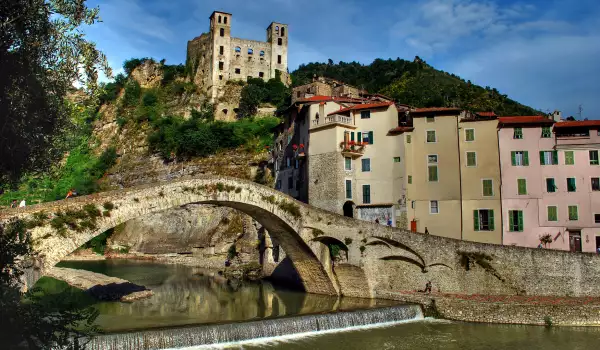Dolceacqua

Immortalized in a brilliant painting of Claude Monet, the castle Dolceacqua is a shining example of Italian medieval architecture. It is built on a hill that dominates the historic town Dolceacqua which is popular with many archaeological sites and is generally one of the important places of historical memories in Italy.
Dolceacqua with its medieval old streets is located in the Liguria region, in the Italian province of Imperia, on the very border with France. This is one of the medieval villages in the Nervia valley and passes through the river town of the same name. Dolceacqua and the buried in ruins castle are located about 120 km southwest of Genoa and about 35 km west of Imperia.
Old Town Dolceacqua is called Terra. It is situated at the foot of Mount Rebuffao and is dominated by the castle. The new part of town known as the Borgo and is located on the opposite bank of the river. In the area of Dolceacqua are found numerous archaeological finds dating from the Iron Age.
The original Roman name of the village is Duciaca, which over time is amended to Dolceacqua. Between the old and new part of the settlement in the 15th century was built a beautiful arched bridge, which is now an indispensable part of the business card of the Italian town.
The castle Dolceacqua is a major historical landmark of the village. The original building was a manor protected during the late 12th century by a round tower. The original owners of the fortress were the Doria family. In 13-14 century, the tower was strengthened and included the construction of firewalls Dolceacqua. In the course of history, the castle underwent many changes.
In the Renaissance, the castle Dolceacqua becomes an elegant and beautiful Renaissance palace, with several new rooms and beautiful interior decoration and furniture. A nice patio surrounds the mansion, but the entire complex is protected by thick walls. The castle was attacked several times unsuccessfully, but in 1744 it was destroyed during the worst attacks in the War of Austrian heritage.
The owners of Dolceacqua abandon it and move to another palace near the main church of the village. In 1887 the palace was severely damaged after a major earthquake. The beautiful Dolceacqua was restored by the local government and used for various cultural events.
The castle was closed to visitors for more than two years and was reopened in 2007 after thorough reconstruction. After this, the floor, masonry and various architectural features were gifted with new vision. A new garden outside the main conference hall of Dolceacqua was added.
For visitors are organized screenings of historical films in a special theater room. Many of the rooms of the palace are occupied by various events, exhibitions or are turned into art workshops. Throughout Dolceacqua are scattered various studios of artists offering their works at affordable prices.






